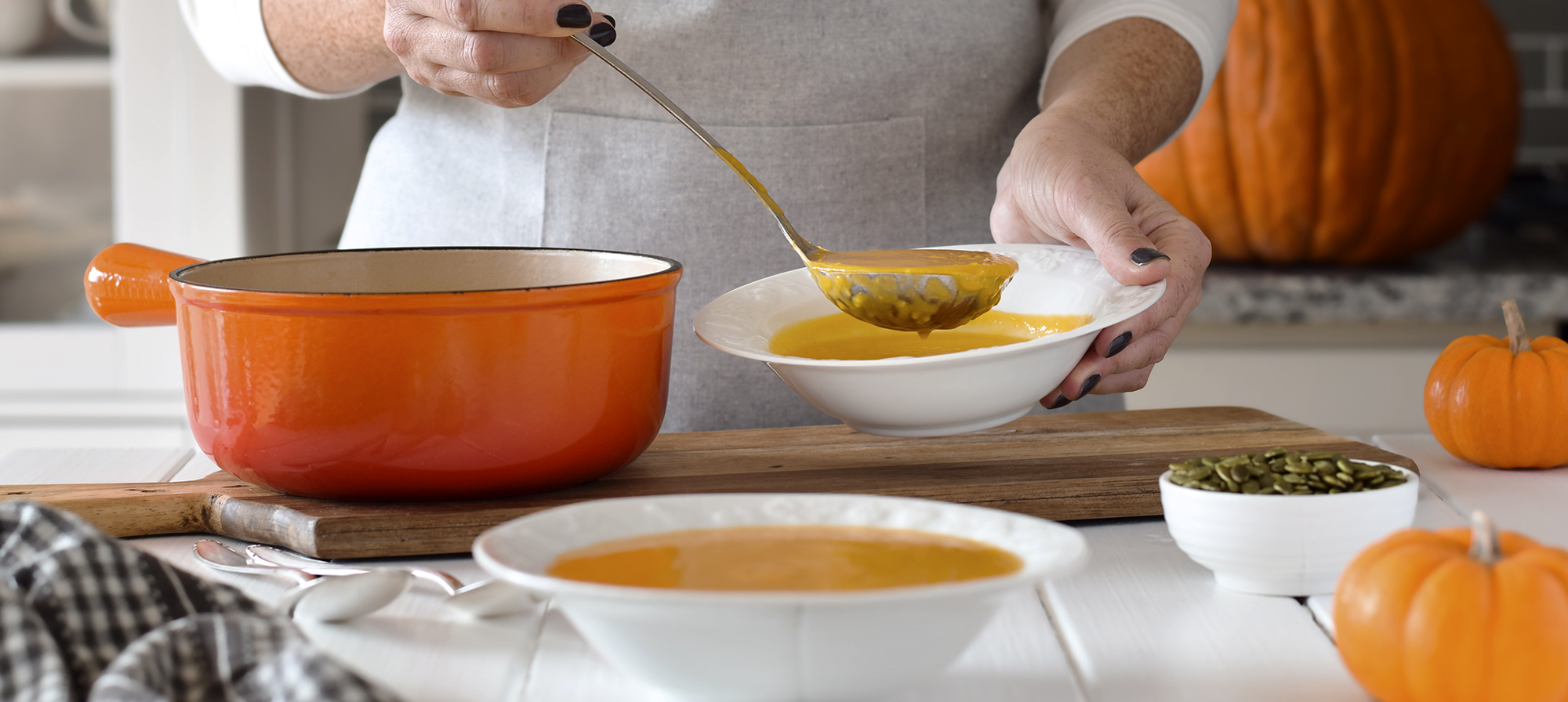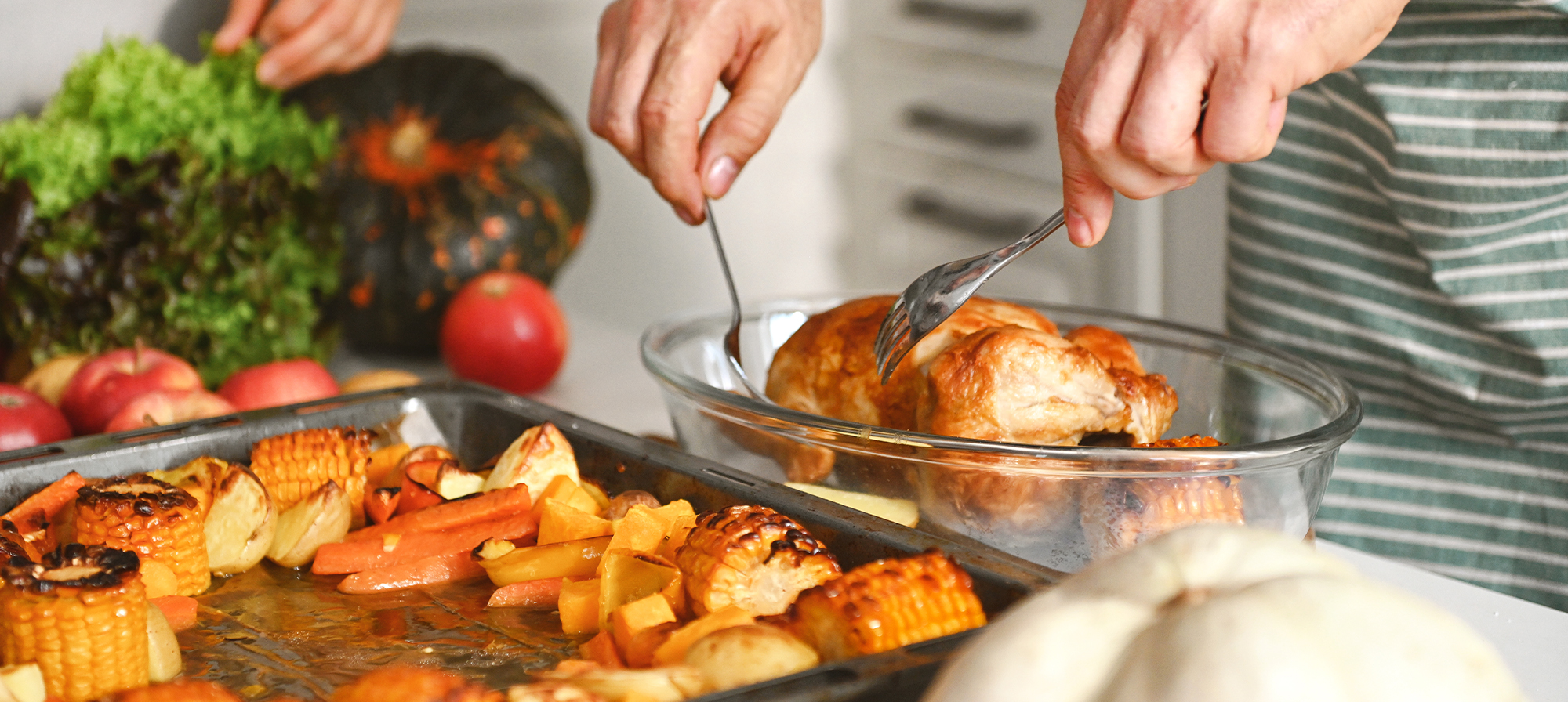Jackfruit is a huge, strange-looking fruit that's become a trendy meat substitute in recent years. Turns out it’s also loaded with health-giving nutrients.
You see jackfruit popping up more and more on restaurant menus these days, often as a meat substitute in vegetarian and vegan dishes. But if you’ve ever come across this huge, alien-looking fruit in the produce aisle, chances are you turned your cart around and ran the other way.
Yet, as daunting as it looks, you may want to give this fruit a chance. It’s chock-full of nutrients that can support your health.
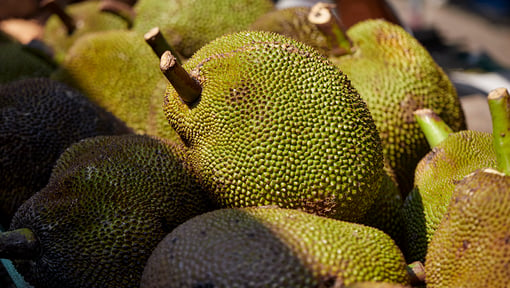
A big fruit with big nutrition and health benefits
Like many other fruits, jackfruit is rich in nutrients. It’s high in fiber, which—among other perks—can help curb appetite, support colon health, and help keep blood pressure at healthy levels. Jackfruit offers plenty of other nutrients, as well. Here are just a few of the nutrients you can find in raw jackfruit:
Vitamins
- A: helps support eye health and may protect cells against free radical harm that can lead to premature aging and a higher risk of certain diseases
- C: helps boost your immune system and is needed to build muscle, cartilage, and blood vessels
Minerals
- Iron: helps support the birth of red blood cells, which carry oxygen to all the tissues of your body
- Potassium: helps muscles and nerves function and regulates heart rate; may also help support healthy blood pressure
- Calcium: helps build strong bones and supports healthy function of your nerves, muscles, and heart
Jackfruit is also brimming with antioxidants. These can help protect your cells from oxidative damage. And compounds in the leaves, seeds, and bark of the jackfruit tree are thought to have antimicrobial, anti-inflammatory, and antibacterial properties, as well as other benefits. Because of this, many cultures use them for medicinal reasons.
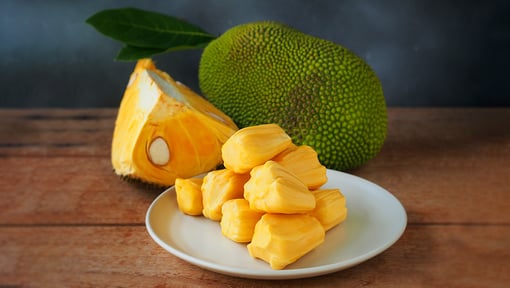
The origin story
Jackfruit is native to India but also grows in tropical rainforest regions of Asia, Africa, and parts of South America. Jackfruit is one of the largest edible fruits in the world. The jackfruit tree belongs to the Moraceae family. This is the same family as figs, breadfruit, and mulberry trees.
In the United States, jackfruit is often imported, but it is grown in a few states, such as Florida, Hawaii, and California. You can find it in season from around May through November. But you may be able to find frozen or canned jackfruit all year round.

Jackfruit as a meat substitute
So, how the heck did a fruit end up becoming a popular meat substitute? Turns out that unripe jackfruit has a meaty texture and a somewhat nondistinctive flavor. That makes it perfect for soaking up the flavor of whatever sauces, herbs, and spices you’re cooking with. It’s also fairly high in protein. So, if you’re looking to cut back a bit on meat, jackfruit makes a tasty, healthy, plant-based alternative.
You’ll often see jackfruit used in savory dishes like curries, pulled “pork” sandwiches, tacos, or soups and stews. If you want to try these or other recipes using jackfruit, just make sure to buy unripe (also called young or green) jackfruit.

Think about giving one of these 18 tantalizing jackfruit recipes try.
You can buy unripe jackfruit in the frozen food section or on shelves in vacuum-sealed pouches. It also comes in cans. Just watch out for high sodium levels, as some canned jackfruit is packed in brine. If you’re trying to keep sodium intake in check, read the label to make sure it’s packed in water. You can also find ready-to-eat ripened jackfruit in cans. Ripe jackfruit is used for desserts, puddings, and in smoothies. It’s often packed in syrup or water.

Whole, fresh jackfruit versus packaged
If you’re feeling daring, you can buy a whole, unripe jackfruit from the grocery store to cut and use as a meat substitute. Just keep in mind that unripe jackfruit may be even harder to cut than ripe jackfruit. Or, if you want to try raw (uncooked) jackfruit, let it ripen at room temperature before cutting it open or buy jackfruit that’s already ripe.
To test for ripeness, gently press the outer skin of your jackfruit with your fingers. It should be slightly soft and give a little. And, unlike unripe jackfruit, a ripe one should give off a faint, fruity aroma. Another sign of ripeness is a yellow-green outer skin. Unripe jackfruit tends to be more green in color.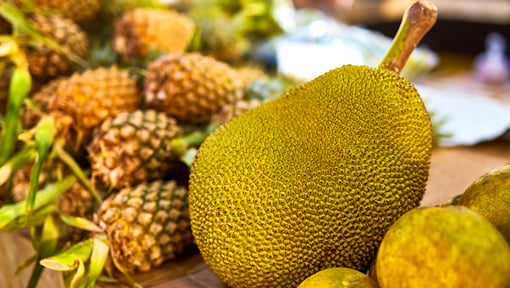 Washing and cutting a whole jackfruit
Washing and cutting a whole jackfruit
If you decide to buy a whole jackfruit from the store, be ready for a culinary adventure of sorts. Cutting and extracting the fleshy fruit and seeds from a whole jackfruit takes time and can be a mess. But if you have the patience, fresh jackfruit is juicy and slightly sweet, tasting somewhat like a combo of banana, mango, and apple.
Besides patience, you’ll also need some upper body strength. A whole jackfruit typically weighs between 9 and 65 pounds—sometimes more. Luckily, fresh jackfruit can come in smaller sizes. Some Asian markets and specialty grocery stores sell precut and plastic-wrapped jackfruit in halves or quarters. These are much lighter and less work to cut.
Before you take on the jackfruit-cutting challenge, you may want to ask your produce person for instructions. Or check for how-to videos online. You’ll likely find that there is more than one way to cut a jackfruit, so watch a few videos first to see which method seems like it will be easiest for you.
Here are the basic steps for one of the many methods for cutting jackfruit:
- Wash your hands.
- Rinse the outer skin of your jackfruit under cold running water.
- Use a large, serrated knife and a large plastic or glass cutting board. Jackfruit, once cut, exudes a sticky sap. Coat your knife with oil, using a basting brush to do so. Using oil keeps the sap from sticking to the knife and a plastic cutting board will be easier to clean up.
- Don a pair of kitchen or culinary gloves. A word of caution: Many online how-to videos suggest coating your hands with veggie oil as well, but that can be slippery and dangerous, especially with the knife also oiled up. It may be safer to use gloves versus oil on your hands during cutting.
- Cut the jackfruit lengthwise in half, and then again lengthwise into 4 quarters.
- Within each quartered segment of jackfruit, you’ll see individual, yellow-colored pods (called arils) of fleshy fruit.
- One at a time, take each of your 4 quartered segments of jackfruit and make horizontal cuts between the pods of fruit. This will help make it easier to remove the fruity pods, along with their seeds.
- Remove as many seeds as you can from the fleshy fruit pods as you go. You can set the seeds aside to roast later. Or you can toss them out. If you take aspirin or any type of blood thinner, talk with your doctor before eating jackfruit seeds as it can possibly interfere with these drugs.
- Once you’ve removed what seeds you can, continue to remove each of the pods of fruit from the inside of the rind.
- Rinse the pods of fruit to remove any sap and enjoy your snack of fresh jackfruit. You can store leftover fruit in the fridge for 3 days, or you can freeze any leftovers for a later time.
Keep in mind that cutting a whole jackfruit takes about an hour. So, think about asking a friend or family member (or two) to help. And if tackling a whole jackfruit feels like too much effort, look for fresh, precut jackfruit in the produce aisle. Or opt for canned, frozen, or packaged jackfruit instead of fresh. The choices are many!
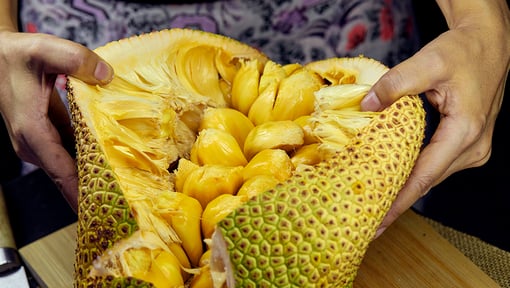
Jackfruit and latex allergy
If you are—or suspect you might be—allergic or sensitive to latex, you may not want to eat jackfruit. Jackfruit contains a latex-like sap. Reported cases of an allergic reaction to jackfruit are extremely rare. But if you have any concerns, avoid jackfruit or talk with your doctor first.
However you slice it, jackfruit is an exotic, versatile, and nutrient-rich fruit with a unique taste and texture. Give it a try the next time you see it on a menu and let the restaurant do the prep and cooking. Or search online for a recipe for cooked or fresh jackfruit and enjoy the fruits of your labor!
Looking for additional new and exotic foods to include in your healthy eating plan? Give one of these 5 not-so-run-of-the-mill pseudo grains a try.
Not a Silver&Fit® member? Learn more about everything the program has to offer, including more helpful healthy living tips like this, here on our website.
This information is not intended to take the place of regular medical care or advice. Please check with your doctor before using this information or beginning any self-care program. Images used for this article do not depict any members of the Silver&Fit Program.
References
American Heart Association. (2016, October 31). How potassium can help control high blood pressure. https://www.heart.org/en/health-topics/high-blood-pressure/changes-you-can-make-to-manage-high-blood-pressure/how-potassium-can-help-control-high-blood-pressure
Florida Department of Agriculture and Consumer Services. (n.d.). Jackfruit. https://www.fdacs.gov/Consumer-Resources/Buy-Fresh-From-Florida/Tropical-Fruit/Jackfruit#:~:text=Season%3A,in%20Florida%20May%20to%20November
Gupta, A., Marquess, A. R., Pandey, A. K., & Bishayee, A. (2022). Jackfruit (Artocarpus heterophyllus Lam.) in health and disease: A critical review. Critical Reviews in Food Science and Nutrition, 1-35. https://doi.org/10.1080/10408398.2022.2031094
Mayo Clinic. (2022, November 4). Dietary fiber: Essential for a healthy diet. https://www.mayoclinic.org/healthy-lifestyle/nutrition-and-healthy-eating/in-depth/fiber/art-20043983
Mayo Clinic. (2020, November 13). Vitamin A. https://www.mayoclinic.org/drugs-supplements-vitamin-a/art-20365945
Mayo Clinic. (2020, November 17). Vitamin C. https://www.mayoclinic.org/drugs-supplements-vitamin-c/art-20363932
Mayo Clinic. (2018, July 17). Cholesterol: Top foods to improve your numbers. https://www.mayoclinic.org/diseases-conditions/high-blood-cholesterol/in-depth/cholesterol/art-20045192#:~:text=Soluble%20fiber%20can%20reduce%20the,day%20decreases%20your%20LDL%20cholesterol
Medline Plus. (2021, November 19). Potassium. https://medlineplus.gov/potassium.html
Petruzello, M. (n.d.). List of plants in the family Moraceae. Britannica. https://www.britannica.com/topic/list-of-plants-in-the-family-Moraceae-2075385
Ranasinghe, R. A. S. N., Maduwanthi, S., D., T., & Marapana, R. A., U., J. (2019). Nutritional and health benefits of jackfruit: A review. International Journal of Food Science, 2019, 4327183. https://doi.org/10.1155/2019/4327183
Rezazadeh, A. (2021, July 1). Growing jackfruit in Florida. University of Florida.
https://blogs.ifas.ufl.edu/stlucieco/2021/07/01/growing-jackfruit-in-florida/
United States Department of Agriculture (USDA). (2018, April). Jackfruit, raw.
https://fdc.nal.usda.gov/fdc-app.html#/food-details/174687/nutrients
Wongrakpanich, S., Klaewsongdram, J., Chantaphakul, H., & Ruxrungtham, K. (2015). Jackfruit anaphylaxis in a latex allergic patient. Asian Pacific Journal of Allergy and Immunology, 33(1), 65-68.
This article was written by Gail Olson, edited by Keleigh Somes, and clinically reviewed by Elizabeth Thompson, MPH, RDN.



